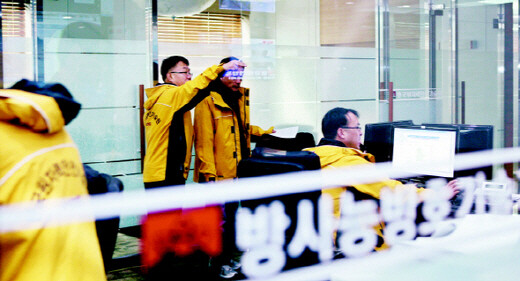hankyoreh
Links to other country sites 다른 나라 사이트 링크
Experts divided over safety of nuclear plants

By Lee Keun-young, Senior Staff Writer
The release of radioactivity Saturday from the Fukushima Daiichi nuclear plant after the massive earthquake that rocked Japan has once again sparked debate over the safety of South Korea’s own nuclear plants. The Lee Myung-bak administration says South Korea’s nuclear plants are earthquake-resistant, having been designed to resist a quake of 6.5 magnitude, but environmental groups counter that the possibility of an accident remains strong since South Korea is not an earthquake-free zone.
South Korea currently commercially operates a total of 21 nuclear reactors at four nuclear power stations - Gori, Wolseong, Uljin and Yeonggwang - including the Singori Nuclear Power Station, which went into operation on Feb 28. Since one nuclear reactor (1 million kW) requires 50 to 60 tons of coolant every second, all are built next to the sea.
“South Korea’s nuclear plants can withstand ground acceleration of up to 0.2g, and even if there is a release of radioactivity, the plants are designed to stop it with five-layer containment walls,” said Hong Nam-pyo, the head of the nuclear safety bureau of the Ministry of Education, Science and Technology (MEST). “Globally, nowhere has an earthquake directly destroyed a nuclear reactor leading to a release of radioactivity.”
Ground acceleration is the force applied to a building by seismic waves: 0.2g could translate into an earthquake of 6.5 magnitude. The administration’s attitude is that current earthquake-resistant designs at nuclear power stations are sufficient since there have been only five earthquakes of magnitude 5 since South Korea began monitoring earthquakes in 1978.
Many feel, however, the possibility remains of a major earthquake of over six or more striking the Korean Peninsula. In the case of Japan, an earthquake struck Nagata Prefecture, previously classified as a non-earthquake zone, in 2007, leading to the release of radioactive material from a spent fuel storage facility of the Kashiwazaki-Kariwa Nuclear Power Plant.
“It is unreasonable to conclude anything about places like Korea located within a plate since earthquake intervals are long and observation has been going on for only 30 years,” said Yonsei University Professor Hong Tae-kyung. “If one considers that there have been large earthquakes several times judging from historical records such as the Annals of the Joseon Dynasty, an earthquake of over 6.0 magnitude could also happen in the future.”
In response, Lee Seong-gyu, director of the Nuclear Safety Division of the Korea Institute of Nuclear Safety, said, “A design standard of 0.2g means even after an earthquake, the plant can operate normally. If one looks at computer simulations, only after a much stronger earthquake would there be a release of radioactive material.”
There is also disagreement over the claim that since Korean nuclear plants use mostly pressurized water reactors, they are safer compared to the Fukushima plant, which uses boiling water reactors.
“The Fukushima plant uses steam heated in the reactor to spin the turbine directly, but Korean plants use a duplicate system in which the heated water from the reactor heats a steam generator, so they are relatively safe,” Kim Gi-hwan, public projects officer with MEST.
However, Yang Lee Won-yeong, director of the organizational activities bureau of the Korean Federation For Environmental Movement, said, “A steam generator, composed of thousands of tubes of several centimeters in diameter and dozens of meters in length, could be weaker in an earthquake in which the ground moves vertically.” Lee added, “The difference in reactor type does not guarantee safety.”
Please direct questions or comments to [englishhani@hani.co.kr]
Editorial・opinion
![[Column] Park Geun-hye déjà vu in Yoon Suk-yeol [Column] Park Geun-hye déjà vu in Yoon Suk-yeol](https://flexible.img.hani.co.kr/flexible/normal/500/300/imgdb/original/2024/0424/651713945113788.jpg) [Column] Park Geun-hye déjà vu in Yoon Suk-yeol
[Column] Park Geun-hye déjà vu in Yoon Suk-yeol![[Editorial] New weight of N. Korea’s nuclear threats makes dialogue all the more urgent [Editorial] New weight of N. Korea’s nuclear threats makes dialogue all the more urgent](https://flexible.img.hani.co.kr/flexible/normal/500/300/imgdb/original/2024/0424/7317139454662664.jpg) [Editorial] New weight of N. Korea’s nuclear threats makes dialogue all the more urgent
[Editorial] New weight of N. Korea’s nuclear threats makes dialogue all the more urgent- [Guest essay] The real reason Korea’s new right wants to dub Rhee a founding father
- [Column] ‘Choson’: Is it time we start referring to N. Korea in its own terms?
- [Editorial] Japan’s rewriting of history with Korea has gone too far
- [Column] The president’s questionable capacity for dialogue
- [Column] Are chaebol firms just pizza pies for families to divvy up as they please?
- [Column] Has Korea, too, crossed the Rubicon on China?
- [Correspondent’s column] In Japan’s alliance with US, echoes of its past alliances with UK
- [Editorial] Does Yoon think the Korean public is wrong?
Most viewed articles
- 1[Column] Park Geun-hye déjà vu in Yoon Suk-yeol
- 2N. Korean hackers breached 10 defense contractors in South for months, police say
- 3Thursday to mark start of resignations by senior doctors amid standoff with government
- 4[Editorial] New weight of N. Korea’s nuclear threats makes dialogue all the more urgent
- 5Kim Jong-un expressed ‘satisfaction’ with nuclear counterstrike drill directed at South
- 6Will NewJeans end up collateral damage in internal feud at K-pop juggernaut Hybe?
- 7[Editorial] Japan’s rewriting of history with Korea has gone too far
- 8[Cine feature] A new shift in the Korean film investment and distribution market
- 9[Column] ‘Choson’: Is it time we start referring to N. Korea in its own terms?
- 10[Column] The clock is ticking for Korea’s first lady